|
EQUINE CLICKER TRAINING..... using precision and positive reinforcement to teach horses and people |


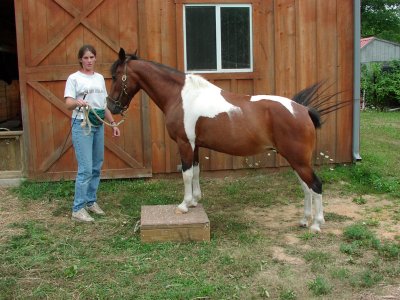
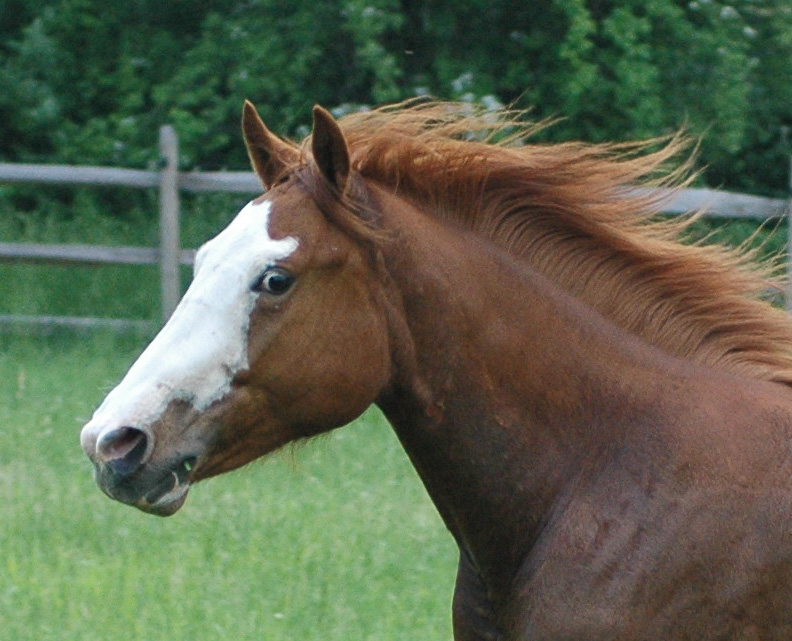
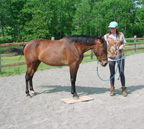

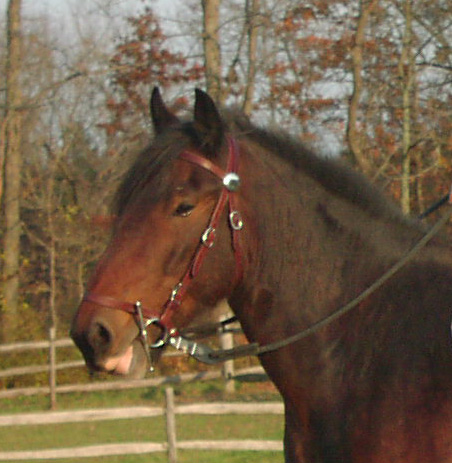
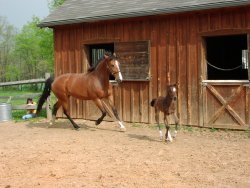 |
|
Ears Forward or Happy Faces When I first started clicker training, my goal was to find some fun activities to do with my young horse, so that we would enjoy training together and develop a better relationship. Because clicker training allows the horse to set the pace of training, this leads to less anxiety and tension because the horse stays within his or her own comfort zone. For many horses, this is enough to improve their attitude and make training sessions a fun and pleasant experience. But for some horses, especially sensitive ones that have had a difficult past or have had physical issues, this is not enough. They seem to enjoy the work, but they remain grumpy and resort to behaviors such as ear pinning when they get frustrated or uncertain. Fortunately, clicker training provides a way to help your horse overcome those grouchy impulses. One of Alexandra Kurlandís core exercises for teaching a horse self control is what she calls "happy faces." Happy faces means teaching your horse to put his ears forward. The idea is that you can access a better emotional state for your horse by teaching him to put his ears forward. It is similar to the idea that smiling can make a person feel better, even if they donít feel they have anything to smile about, or that laughing is good for you, even if you donít feel like laughing. In horses, emotional states are related to body positions. This is why teaching head lowering is so useful, as you can use it to calm your horse down. A horse that has his ears forward is going to be interested, eager and confident. By teaching your horse to put his ears forward, you can tap into the emotional state that goes along with it. When I first read about this, I thought it was a great idea, but wasnít sure how to teach it and I wondered if by teaching my horse to put her ears forward, I would somehow be disrupting her method of communicating with me. Since I have started teaching people about "ears forward," I find that these are common concerns. And I think it is valid to question teaching any behavior that could mask a horseís concerns and lead to lack of communication between you and your horse. If my horse is concerned about something, I want to know. I donít want my horse to put her ears forward when things are not ok. But I decided to give it a try, mostly because I had the perfect candidate in my barn (that would be Rosie.) If you are reading this, my guess is that you have a grumpy horse too. So, I will tell you that it does work and not only will it improve your horseís mental state, but it will improve yours too. For those of you who havenít read about Rosie, you might want to read about her in the web page titled "How I found clicker training." Letís just say that when I started this project, Rosieís standard response to anything was to pin her ears and threaten. If things were not to her liking, she would pin her ears. If I was late for breakfast, the other horses would say "yeah..youíre here." Rosie would say "Iím so mad at you, why werenít you here." I used to joke that she was like a person before they had their morning coffee. As of this writing (September 2005), Rosie is great at putting her ears forward. So, yes, this really does work. I have experimented with other horses too and it has worked on them too. But they were horses where it was enough to just click when their ears were forward a few times and they figured it out. Rosie was harder, and thatís why she needed it more. These days, I find it quite funny to see Rosie carefully adjusting her ears to earn her click. The speed at which she puts her ears forward, if she keeps them there and her general facial expression provide just as much information about her mental state as I need, and if she is really unhappy, I know it because she wonít put her ears forward at all. So, if you are interested in learning how to teach your horse to put his ears forward, and you think it might be more complicated than just free shaping ears forward a few times, then read on. I am going to tell you the story of how I trained Rosie to put her ears forward. When I first started writing this article, I was just going to write a concise description of various methods for teaching ears forward, and why to do it. But, I am rather fond of stories (both writing them and reading them) and I think there is a lot of value in reading how a trainer worked through a problem and how training evolves over time if you are willing to keep playing with something. If you prefer to skip to the suggested strategies and tips, then you can skip to the end and I have listed my suggestions for how to go about training ears forward. The first thing I did was to think about Rosieís behavior and where she pinned her ears the most. For her, it was when she was in her stall and someone approached her or entered her stall and did something unexpected. She loves routine and would allow me to come in her stall and bring feed and water, but if I turned and bumped or, or touched her when she wasnít expecting it, she would pin her ears. In the early days of our relationship, she might have threatened to kick me or snaked her neck, but we were past that. Now she allowed my presence and handling, but she made it pretty clear that she wasnít happy about it. This was the place where I really wanted to be able to ask her for ears forward. But I didnít start there because that would have been too hard. Instead I spent a lot of time capturing ears forward when she was in other places. I would click for ears forward while grooming, or when we were practicing mat work or other times. I have to say that Iím not sure she really got it. She was generally pleasant outside her stall and we were working on other things at the same time, so I didnít see a big change in how much she put her ears forward and she was just as grouchy over her stall door. So, I decided to concentrate on teaching ears forward over her stall door so that this would be her default.html behavior when I approached. I spent a few years playing with this sporadically. My first attempt was to use free shaping and just click when her ears were forward. Here is where the clicker really helps. I could catch that brief moment when she had both ears forward and then walk forward and feed her. I found that it was easier to click for one ear forward than both, as she usually moved her ears a lot. I figured that if one ear was forward, then she didnít have them completely pinned so that was ok. We made some progress but I have to say that I didnít end up with the result I wanted. She was better over the door, but she was not as consistent as I would have liked and sometimes she made horrible faces between the click and treat. So, next I tried using a target. This worked great. I could get her to touch the target and if it was something novel, she would have her ears forward. I tried adding a verbal cue and I also tried hiding the target in my jacket and then presenting it so that she would offer ears forward in expectation of the target. The idea was that I could eventually get ears forward without needing the target. She didnít seem to connect the verbal cue with ears forward and was very fixated on the target so I moved on. I decided that since she was not acting out on her grumpiness, I would just ignore the ears but I would click if she put them both forward. I might also click if she had a pleasant face but I was not too specific about what "pleasant" meant. As long as her ears werenít pinned back and her nostrils and nose were relaxed, I could click her and give her a carrot when I approached. If she did happen to put both ears forward, then I would give her a jackpot. At this time, she lived in the end stall in the barn by an open doorway and I found that she was offering ears forward more and more, but what was happening was that I was rewarding her for putting both ears forward when she was looking at something out the open doorway so I taught her what I now call " the stare off in the distance and look at something" pose. So, I had ears forward but she was not looking at me. Ok..so I stopped clicking that. Soon after that, I stopped working on this with her as she had her foal and I was busy with other things. She was reasonably pleasant for most things and I wasnít working with her a lot in her stall so I would just give her a treat over the door every now and then. When her foal was weaned, we moved her to a different stall that had a grill over the top of the door and then it didnít matter so much if she was grumpy when I approached. If she was grumpy, I just ignored her. About 2 years later, I picked it up again. I was getting ready to start working her again and I had decided that I really couldnít stand the idea of working with a horse that seemed to hate me. Did she really hate me? No, I donít think so, but it sure felt like it. I found it very unpleasant to walk into the barn and have her pin her ears when I approached. I had also found with my earlier work, that clicking for ears forward improved my attitude. By giving myself a concrete behavior to reward on a consistent basis, I removed some of the emotional fallout that comes from walking into the barn and having your horse snark when you go to pat her. Days like that became just another day to work on ears, and I learned to really appreciate the days when I walked in and she was pleasant. This allowed me to distance myself a bit. Instead of feeling like she was mad at me, I would ask her "what is bothering you today." In the course of teaching ears forward, I have learned a lot about Rosieís likes and dislikes and personalities. I know what kind of things make her crabby (bad weather, late meals, aches and pains from various pasture mishaps etc..). I have probably learned more about her personality from this single project than from anything else. It has made me a good observer of my horseís facial expressions. In order to work on ears forward over her stall door, I had to remove the grill. She loved this and was thrilled to be able to stick her head out again. So I decided to take advantage of her good mood and the first thing I did was to put her on a really high rate of reinforcement over her door for a month or so. Every time I walked by her stall, I clicked and treated her. I didnít click if she was being mean, but I was not too particular about what kind of face she presented, as long as it was reasonable. My logic was that I wanted her to really understand that good things happened when I approached her door. After the month was up, I decided to work more specifically on ears forward. One day I was standing by her head, just patting her and waiting for her to tip even one ear forward, when I could see it wasnít going to happen and in a moment of silliness, I gently took her ears and pushed them forward and said "see, this is what I want.." I was amazed at how tight her ears were and it occurred to me that ear handling was a useful thing to work on with her. Maybe if she learned to relax her ears, she would be calmer. I was also aware that Linda Tellington-Jones does a lot of ear work with horses in stressful situations. So I just stroked and rubbed her ears and did ear circles and when she relaxed her ear and let me move it, I clicked. I did this daily for a few days and she got much more accepting of having her ears handled and she would allow me to move them around and even to put them into "ears forward" position. Now, I know this sounds kind of silly, but I didnít really have a plan at this point. I was just playing. But one day I realized that she was letting me put one ear forward and was holding it there briefly, so I clicked that. I started concentrating on one ear at a time and clicking for forward motion. We were having a lot of fun with this when one day I noticed that something interesting was happening. She was anticipating the ear handling and putting her ear forward when I stretched my hand out toward it. This was great. I suddenly had a good cue for ears forward and it was when I reached out toward her. I found that I could do this with both hands (one at a time) and she would put that ear forward. I experimented and found that I could get her to put her ear forward if I patted her face by adding that as a pre-cue. If I put my hand toward her face and she didnít put her ear forward, then I slid it up toward her ear and clicked for her ear and then went back to her face. She figured out pretty quickly that if I patted her face on the way to her ear, she could get clicked sooner by putting her ear forward when I patted her face. This is a great ears forward cue because it is common for most people approaching a horse to reach out and pat their face. To Rosie, the hand reaching out meant ears forward instead of being perceived as a threat. We worked on this for a long time. She got better and better about putting her ears forward as I approached and allowing me to touch her face without getting unpleasant. I could walk toward her from a distance and she would put her ears forward when she saw me coming. This was a huge step forward, but now that I could see that there was still room for improvement. What was happening was that I was getting ears forward, click and as I walked toward her to give her the treat, the ears were going back again. It was not always that unpleasant "Iím going to bite you face." Sometimes it was just her ears flicking back and forth to check out what was going on around and behind her. I do think that with a very distractible horse, or one that is very tuned in to her environment, it is asking a lot for her to concentrate solely on me when she is not actively moving her body. I have found with Rosie, that the more she is moving, the less distracted she becomes. So, if I am working on an exercise that is stationary or at the walk, she loses her focus quicker than if we are working at the trot. So standing still with both ears forward is difficult for her. She wants to be flicking them around checking to see what is happening. At any rate, I was losing her between the click and treat. Now according to the rules of clicker training, she gets to end the behavior at the click so I did not feel it was fair to expect her to keep her ears forward while I delivered the treat, unless I actively trained that behavior. I had a number of choices for how to proceed. One option that I know works for some people is to click for the behavior, walk forward and wait for a pleasant face before delivering the treat. This works really well for a muggy horse. You click and then wait for the horse to turn his face away before giving his treat. I also know people who have used this technique on horses that pin their ears when getting the treat. I also had the choice of delaying the click and asking her if I could come closer and have her keep her ears forward. And, of course, I had the option of ignoring the behavior after the click and hoping that over time, as she learned that my approach after a click was always a good thing, the ear pinning would decrease. I had experimented a little early on with waiting for ears forward before treating and I felt that this was very frustrating for Rosie, so I decided to use the second approach. And to make things clearer, I decided that I would only concentrate on one ear. This turned out to be a great compromise because it allowed her to keep in touch with her environment with one ear and focus on me at the same time with the other ear. For the sake of clarity, I chose to click her when her right ear was forward. For those of you who are having difficulty getting ears forward, I strongly recommend picking one ear and working on that. It seems to add a level of clarity and you are much less likely to have a badly timed click. And, if you happen to get both ears forward, you can jackpot it. Not only that, as you get one ear consistently forward, it is easier to catch the other ear coming forward and then you have both. So the plan was to approach Rosie and stop. If she put her right ear forward, I would praise her and take a step forward. If she kept the ear forward, I would click and treat. At this time, I was treating her regardless of what she did between the click and treat. I could have asked for ears forward again by walking all the way up to her and patting her face, but I decided to concentrate on having her learn that if she wanted me to continue to approach, then she needed to keep the right ear forward. So, for a few days, it went something like this: I approach, hesitate, Rosie puts her right ear forward, I say "good girl" and take a step. If the ear stays forward, I praise and take another step. If the ears stays forward, I click and treat. I varied how many steps I took before clicking so that some times it was easy for her and other times, she had to hold it forward longer. Over the next week, I slowly built up until most times I could approach and she would keep her right ear forward. In the course of this, I learned some interesting things. Her ability or willingness to keep her ear on me was related to where I was coming from. If I was entering the barn from the outside, or from the tack room, she was much more likely to be able to keep her ear forward. If I was walking down the aisle, she was much less confident. I did a lot of approach and retreat using her ear as a guide. If I waited and she didnít put her ear forward, I backed up a step. This would often cause her to put her ear forward and then I would praise and step forward again. This eventually evolved into a cue itself. If I approach and she doesnít put her ear forward right away, I can take my body (or even my energy) back and she will often correct herself. After working with this, I really do believe that the ear pinning did not mean "go away," but more likely meant "Iím not sure what you want" or just was an expression of inner conflict. She wanted me to come, but she really thought she needed to protect her space too. One thing I like about this is that I have ended up using her right ear as a way for her to tell me when she wants me to approach. So if I am walking down the barn aisle and she looks at me and tips her right ear forward, I will come up to her and give her a click and treat. If I am walking down the aisle and she is looking grumpy and she looks at me and pins her ears, then I just keep doing what I am doing. Sooner or later, as I go up and down the aisle doing my chores, she will decide that she wants me to come over and she will ask by putting her right ear forward. Itís really pretty funny and I like that she has some control over whether she feels like being sociable or not. So thatís where we are now. I should add that once I had done the initial work with ears forward with my hand as the cue, I was able to add ears forward to other behaviors such as mat work or standing square and she seemed to have a better understanding of what I was clicking. I am sure that I will keep playing with this. It is a great ongoing project because I have many opportunities to reinforce her as I go about my work in the barn. I have also found that it has given me a lot of insight into her personality and into what is required to really get a behavior solidly on cue. I have learned how important it was to stick with my criterion and to be consistent. It is so hard to just click right ear forward when she offers the other ear or her mini-pose or other behaviors. NowÖfor those of you who might want to play with training ears forward, here are some tips that might help you. Good Strategies Train ears forward in conjunction with having the horse look at you (this avoids training the "stare off in the distance at something interesting" ears forward which is ok, but not exactly what most of us want) Start in an environment where the horse is comfortable. I did spend a lot of time clicking for ears forward while Rosie was standing for the farrier etc..So donít start this in the location where your horse is the grumpiest. It is ok to start with clicking for one ear forward and then go to two ears. I found it worked better to pick an ear and stick with it instead of clicking for either ear forward. I love having the hand reaching out be a cue for ears forward. You donít have to use this, but I think it is worth paying attention to what cues are evolving out of the shaping process and taking advantage of a great one coming along. The key is to reinforce this A LOT and to be really consistent.
Benefits for Trainer This is great practice in timing and free shaping, duration Develops your creativity in coming up with ways to get your horse to consistently put her ears forward Teaches you to be consistent improves your ability to read your horseís emotions, likes and dislikes having your horse act more pleasant will make you feel more generous toward your horse teaches you to train without getting emotionally involved. This is a big one. Now when your horse pins her ears, you donít take it personally, you just take it as a training opportunity. Benefits for the Horse a chance to get rapid and consistent reinforcement for a simple (physically) behavior increased emotional control improved relationship with your trainer through a stronger association between treats and good things and her presence. increased confidence because the trainer is very clear and consistent about what is expected. For some horses, working on a new behavior every week is frustrating as they just want to know they have the right answer when you approach. Sticking with one behavior removes some of their anxiety. A pleasant horse is treated better by everyone she encounters. She gets to look beautiful in all those nice pictures you take, now that you can ask for her to put her ears forward. I hope this has inspired you to go out and try this with your grumpy horse. I truly believe that Rosie is a happier horse, and I know that I am a happier owner because we have spent so much time working on this. She loves having the right answer and I know she loves being able to ask me to come see her by pricking that right ear at me.
Home | Articles | Clicker Basics | Community | FAQ | Getting Started | Horse Stories | Links | Photos | Resources
|
||||